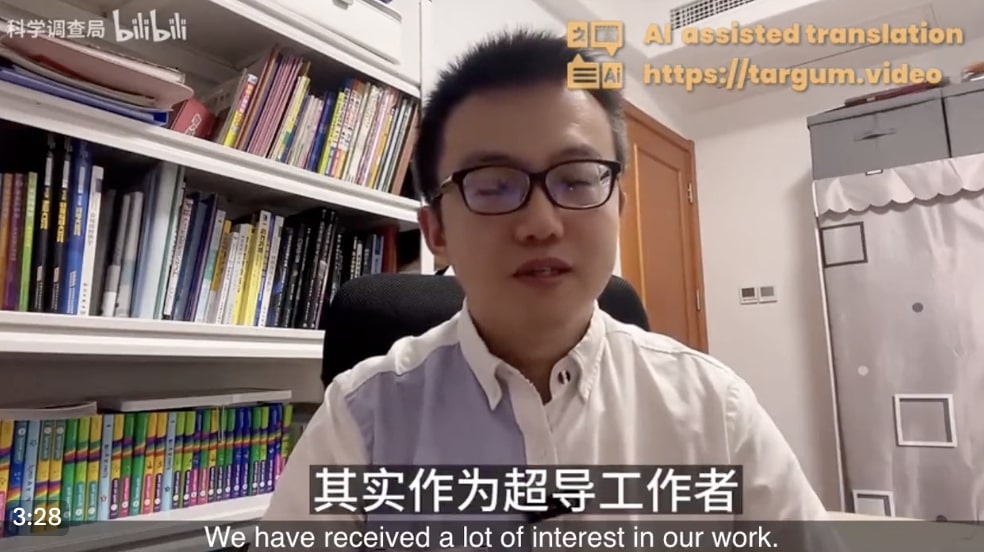Southeast University of Nangjing China have published their preprint to follow their video. They claim to measure ‘zero resistance’ which is to say, they measure a resistance as small as possible giving the limitations of their measurement setup. It is difficult to setup a measurement of the sample due to its flaky material properties. The discontinuities in resistance at higher temperatures may be due to electrode contact resistance.
I had a prior article on the video made by Southeast University. The embedded twitter links below have the video as well.
They measure a sample with a very high critical field. Higher and higher magnetic temperatures do not seem to affect the temperature at which it enters its lowest-conductive state. They report this as ‘critical temperature’. Superconductors usually have a sudden drop in resistance but his material has a smooth decline in resistance as it cools.

This part of the paper indicates that they think making larger and more pure samples could show the Meissner effect.


Conclusion from the Paper
They successfully synthesized the compound Pb10-xCux(PO4)6O, and observed the zero resistance above 100 K. However, the Meissner effect has not been observed yet in our samples, which suggests that the superconducting volume is relatively low. they still need more evidences to confirm the superconductivity, and to identify which component is in charge of the zero resistance (superconductivity). Besides, whether the Tc could be enhanced up to room temperature is still an open question.
Abstract
Room-temperature superconductivity has always been regarded as the ultimate goal in the fields of solid-state physics and materials science, with its realization holding revolutionary significance, capable of triggering significant changes in energy transmission and storage. However, achieving it poses various challenges. Recent research revealed that material Pb10−xCux(PO4)6O displays room-temperature superconductivity under atmospheric pressure, sparking global interest in further exploration. Here, we utilized solid-phase synthesis to obtain a polycrystalline sample of Pb10−xCux(PO4)6O. X-ray diffraction confirmed its structural consistency with referenced literature. Zero resistance, which is important evidence for superconductivity, was observed above 100∘ K under ambient pressure in our experiment. Our finding indicates that Pb10−xCux(PO4)6O is a possible candidate for searching high-temperature superconductors.
First independent measurement of zero resistance in LK-99
A team of scientists from the Physics Department of Southeast University, a top university in Nanjing, China, have reported measuring 0 resistance in a sample of LK-99 they synthesized from scratch.
Here is the video:
-… pic.twitter.com/QXas3L0S8j— Andrew Cote (@Andercot) August 2, 2023
Update from SouthEast uni in China about LK-99 translated to English: https://t.co/AnFXTuXPlU
I'm not sure if he's saying "super islands" or what the hell, will check w/ translor and update but here's it so far
I am Sun Yuyue from the School of Physics at Southeast…
— Alex Volkov – targum.video – I WANT TO BELIEVE (@altryne) August 2, 2023

Brian Wang is a Futurist Thought Leader and a popular Science blogger with 1 million readers per month. His blog Nextbigfuture.com is ranked #1 Science News Blog. It covers many disruptive technology and trends including Space, Robotics, Artificial Intelligence, Medicine, Anti-aging Biotechnology, and Nanotechnology.
Known for identifying cutting edge technologies, he is currently a Co-Founder of a startup and fundraiser for high potential early-stage companies. He is the Head of Research for Allocations for deep technology investments and an Angel Investor at Space Angels.
A frequent speaker at corporations, he has been a TEDx speaker, a Singularity University speaker and guest at numerous interviews for radio and podcasts. He is open to public speaking and advising engagements.


Is the cat in the box alive or not?
Is LK-99 superconductor at room temp or not?
Both states are possible.
There are numerous replications of Meissner effect in small grains and thin layers at room temperature on video. Clearly we have a mix of grain structures in the bulk material.. There’s a paper out there from 2018 titled, ” Emergence of superconductivity in the cuprates via an unusual percolation process”. The key concept in that paper is ‘percolation’ (like water through soil) where a “sample-spanning cluster” of superconducting grains forms a network of channels in the material… This phenomenon leads to flickers of superconductivity above Tc. The takeaway: there is room temperature SC in some grains. Sounds super promising to me. Sure, their sample became [bulk] SC at 110k – not the end of the story.
Fix the title and other references to Kelvins – the unit is not degree of Kelvin, it is just K.
Edit: I see now that the degree is already in the preprint, quite a silly mistake for university members.
AFAIK, it is less common, but not a mistake to say “degree Kelvin”, just like you can say degree Fahrenheit or degree Rankine. They’re all just different scales of temperature.
It’s a new class of sc material with new properties. Gave the DFT modeling folks a chance to try out their new models, and that seemed successful. LK-99 is probably not the only one in this new class, but more like a starting point. I think one Chinese researcher already recommended using gold to dope instead of copper. It’s a whole new adventure. Reminds me of 1987 wit YBCO.
It is superconductive at very low temperatures, way below freezing point. The material is brittle, perhaps hard to work with. It is superconductive at normal pressure what is a good thing.
At room temperature they noticed resistance drop. That was unexpected. The resistance drop is not high enough to be classified as superconductor. Semiconductor. Still it is worth to research the resistance drop, not clear if the drop can be higher all the way to superconductivity or not,…